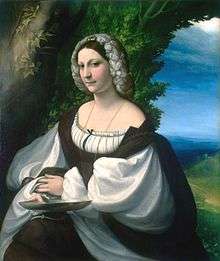Veronica Gambara

Veronica Gambara (November 30, 1485 – June 13, 1550) was an Italian poet, stateswoman and political leader.
Biography
Born in Pralboino (now in the Province of Brescia), in Lombardy, Italy, Gambara came from a distinguished family, one of the seven children of Count Gianfrancesco da Gambara and Alda Pio da Carpi.[1] Her family contained a number of distinguished female intellectuals, including her great-aunts, the humanist poets Ginevre and Isotta Nogarola.[2]:164 Veronica was also a niece of Emilia Pia, the principal female interlocutor of Baldessare Castiglione's Il Cortegiano.[3]:160–61
Gambara received a humanist education, studying Latin, Greek, philosophy, theology and scripture.[3]:160[2]:170 In 1502, at the age of 17, she began corresponding with the leading neo-Petrarchan, Pietro Bembo, who became her poetic mentor two years later when she began sending him her compositions.[3]:161[2]:170
In 1509, at the age of 24, she married her cousin, the 50-year-old widower Giberto X, Count of Correggio, in Amalfi.[1] They had two sons, Ippolito was born in 1510 and Girolamo in 1511.[1] After Giberto's death in 1518, she took charge of the state (including management of Correggio's condottieri), as well as the education of her two sons and step-daughter Costanza.[4]:23[2]:171
Under Gambara's rule, the small court of Correggio became something of a salon, visited by such important figures as Pietro Bembo, Gian Giorgio Trissino, Marcantonio Flaminio, Ludovico Ariosto, and Titian.[2]:170[4]:25 Previously aligned with French king, Francis I, Gambara allied Correggio with Holy Roman Emperor Charles V.[1] She personally received Charles V at her estate in 1530, when he signed a treaty guaranteeing Correggio would not again be besieged, and a second time in 1533.[1] The treaty was broken, however, in 1538 when Galeotto Pico II, Count of Mirandola and Concordia, launched an attack on Correggio.[4]:24 Gambara organized a successful defense of the city, and between 1546 and 1550, saw that Charles V paid for improved fortifications.[4]:24[1]
Poetry and correspondence
Approximately 80 of her poems and 150 of her letters are extant, and a complete English translation of her poems was published in 2014.[5] Little of her poetry was published during her lifetime, though it circulated in manuscript and was well-known throughout Italy by 1530.[2]:169 Gambara primarily composed poetry in Italian falling into four categories: poems on political issues, devotional poems, Virgilian pastoral, and love poems to her husband.[2]:170–71 Her political poems are particularly notable for expressing a concept of Italy as an entity centuries prior to unification.[4]:24 Most of her poems are sonnets, although she also wrote madrigals, ballads, and stanze in ottava rima. She also composed a number of poems in Latin, including an ode for Charles V with which she greeted the fellow sovereign on his visit to Correggio in 1530.[2]:170–71
Gambara was in correspondence with a number of important scholars and poets of the day. Beyond the above-mentioned Pietro Bembo, she corresponded with the poet Bernardo Tasso, the writer Matteo Bandello, and author and playwright Pietro Aretino (who would come to slander her as a "laureated harlot," an attack Gambara simply ignored).[4]:24[2]:171 She also exchanged letters with Charles V.[1] Gambara's letters, never intended for publication, shed light on her personal life. In a 1549 letter to Ludovico Rosso she admits to exhaustion with her responsibilities, and expresses a desire to retire to a solitary country life.[1][4]:25
Notes
- 1 2 3 4 5 6 7 8 9 Moody, Ellen (April 19, 2004). "Under the Sign of Dido: Veronica Gambara (1485–1550), Life, Letters, and Poetry". Retrieved June 11, 2018.
- 1 2 3 4 5 6 7 8 9 Stevenson, Jane (2005). Women Latin Poets: Language, Gender, and Authority, from Antiquity to the Eighteenth Century. New York: Oxford University Press.
- 1 2 3 Robin, Larsen and Levin (2007). Encyclopedia of Women in the Renaissance: Italy, France and England. Santa Barbara: ABC-CLIO.
- 1 2 3 4 5 6 7 Stortoni, Laura (1997). Women Poets of the Italian Renaissance: Courtly Ladies and Courtesans. New York: Italica Press.
- ↑ Martin, Molly; Ugolini, Paola (June 2014). Veronica Gambara, Complete Poems. A Bilingual Edition. The University of Toronto.
References
- Robin, Diana Maury, Larsen, Anne R. and Levin, Carole (2007). Encyclopedia of women in the Renaissance: Italy, France, and England. ABC-CLIO, Inc. pp. 160–61.
- Under the Sign of Dido: Veronica Gambara (1485–1550), Life, Letters, and Poetry Ellen Moody April 2004. Accessed July 20012.
- Stevenson, Jane (2005). Women Latin Poets: Language, Gender, and Authority from Antiquity to the Eighteenth Century. New York: Oxford University Press. pp. 156–171. ISBN 0198185022.
- Stortoni, Laura A (1997). Women Poets of the Italian Renaissance: Courtly Ladies and Courtesans. New York: Italica Press. pp. 23–5. ISBN 0934977437.
- Martin, Molly; Ugolini, Paola (June 2014). Veronica Gambara, Complete Poems. A Bilingual Edition. The University of Toronto.